Growing plumeria in pots is a great way to enjoy them no matter where you live. In this post, I’ll show you all you need to know in order to be successful.

Learning how to grow plumeria in pots is a good option if you don’t have space in your yard, or you live somewhere that’s too cold to leave them outside year round.
But caring for them in containers is a little different than it is for those planted in the ground.
In this detailed guide you’ll get all the information you need to grow plumerias in containers.
From how to choose the right pots, soil, and location, to how to water, fertilize, and much more, you’ll find it all here.
Growing Plumeria In Pots vs Ground
Plumerias thrive in pots, and it allows you to keep them anywhere. Whether that’s a sunny place in your garden, a porch, or a bright corner inside your house.
It’s especially great for anyone living in cooler climates, since you can easily overwinter them indoors.
Another benefit is that you have complete control of the type of soil, and containers also make it much easier to give them plenty of fertilizer.
Related Post: How To Grow & Care For Plumeria Plants
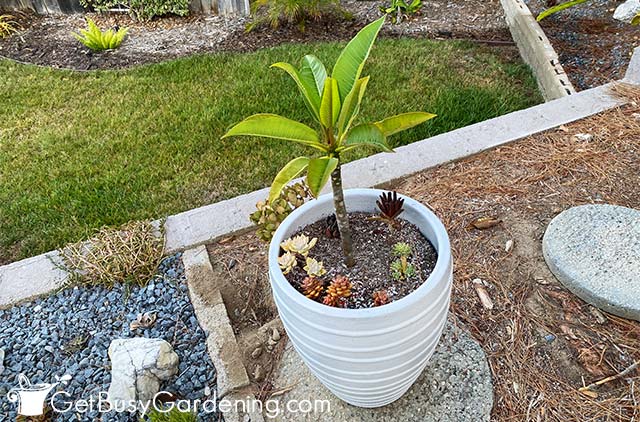
Do Plumerias Do Well In Pots?
Plumerias do very well in pots, and it gives you the ability to control their size, nutrients, and moisture levels.
It also allows you to put them wherever you want. They can spend spring and summer outdoors, then you can move them to somewhere warmer when the fall temperatures start to drop.
How Big Do Plumerias Get In Pots?
Potted plumeria plants can get very large, but it’s dependent on the container size. They’ll grow to fill their given space.
If you put them in a big pot, you can expect a large tree over time.
They can live in the same pot for many years if you trim both the branches and the roots as needed to manage the overall size.
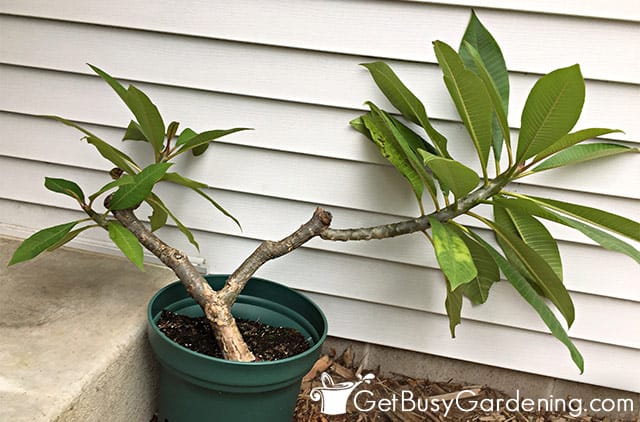
How To Grow Plumeria In Pots
Choosing the right pot for your plumeria is key for growing them in containers. Let’s talk about how to give them the best home.
Different Types Of Plumeria To Grow In Pots
Some large or tall tree varieties of frangipani can be difficult to grow in pots. Instead choose a compact, dwarf specimen to make managing the size easier. Here are a few good options.
- Plumeria obtusa “Dwarf Pink Singapore” – This petite variety has pink-edged white flowers that can bloom year round.
- Plumeria rubra “Penang Peach” – This type stays compact and features white flowers with yellow centers.
- Plumeria rubra “Thailand Red” – The very compact nature of this one makes it perfect for containers, and it produces profuse yellow-pink blooms.
- Plumeria rubra “Dwarf Watermelon” – Also known as “Dwarf Cherry Clusters”, this variety has abundant bright pink flowers.
Best Pots For Plumeria
For the best success, it’s important to use a good pot for your plumeria. They like a lot of water, but hate wet feet, so choose one with drainage holes.
Size is also important. It needs to support the weight of the top-heavy plants without tipping over. But it’s best to avoid one that is much larger in proportion.
If the container is too big, it’s easier to overwater. Plus it will result in a much larger plant over time, which may or may not be ideal for you.
As far as what it’s made out of, many times the material you choose comes down to personal preference.
Plastic and fabric are good options because they’re lightweight enough to move them if you need to.
Terracotta and ceramic are heavy enough to avoid tipping, but the extra weight also makes them much more difficult to move.
Related Post: How To Propagate Plumeria Plants
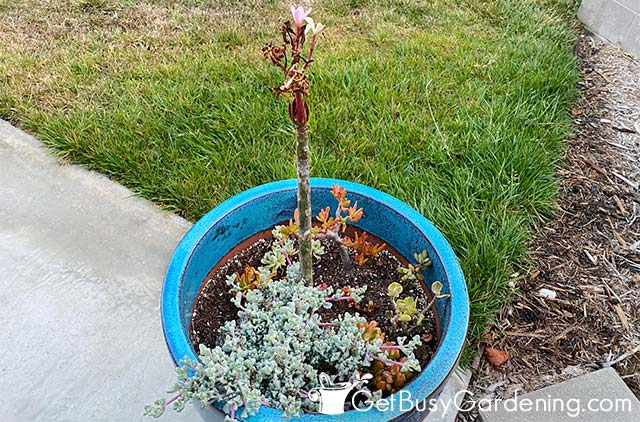
Best Soil For Plumeria In Pots
It’s important to always use a high quality, fresh, sterile potting soil for plumeria in containers.
Never use cheap dirt or soil from the ground, as they can introduce pests and disease, become compacted, and are often nutritionally depleted.
The ideal medium is slightly acidic and free-draining. A sandy commercial mix can work well.
Or, make your own by combining equal parts regular potting soil, pumice or perlite, and coarse sand.
Learn all about the best type of soil for plumerias and how to make your own in my detailed guide.
Tips For Planting Plumeria In Pots
When it comes time for planting, slide it out of the existing pot. If the roots are forming a circular pattern, then carefully loosen and straighten them out.
Center your plumeria in the new pot, and bury it at the same depth it was in the original one.
Fill in around the rootball with soil, gently packing it in as you go. Once the container is full, give it a light drink of water. After everything settles, fill in any holes that appear.
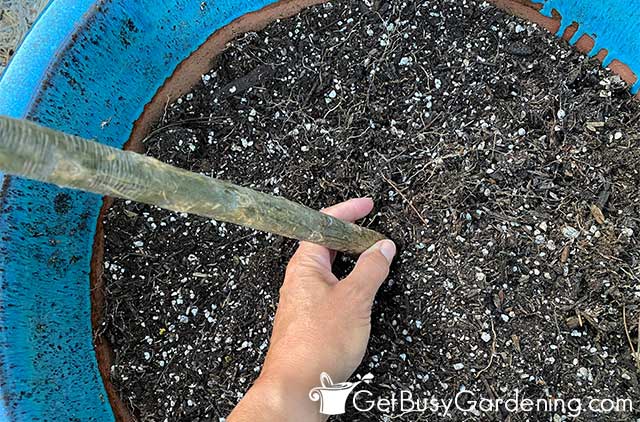
How To Care For Plumeria In Pots
Once you understand what they need, it isn’t difficult to care for a potted frangipani. In this section you’ll find detailed tips for how to keep yours thriving in a container.
Watering Plumeria In Pots
Plumeria like lots of water, but too much can cause issues with rot, mildew, and disease, which is especially a problem in pots.
It’s best to wait until the top 2-3” of soil is dry, and then give it a slow, deep drink. Let all the excess drain out of the bottom of the container so they’re never left soaking. A moisture meter is a helpful tool if you tend to overdo it.
Cold can shock them, and they’re sensitive to some of the chemicals and salts in tap water, which can build up in the container. So use room temperature rain or distilled water rather than tap, if possible.
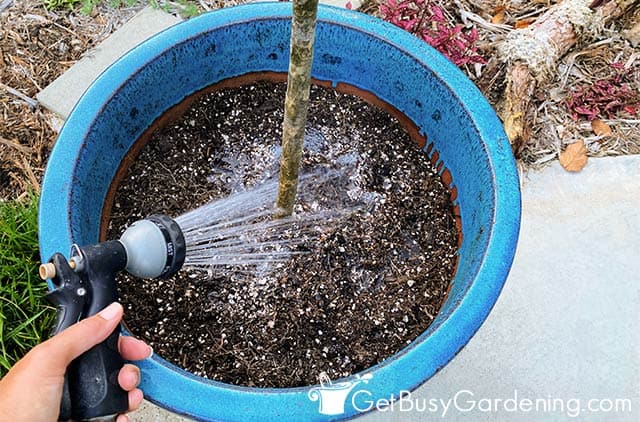
Fertilizing Containerized Plumeria
Plumerias are heavy feeders, and those in containers will need a lot more fertilizer than ones in the ground.
A high phosphorus liquid flowering plant food is a great option. Start feeding them with a 1/4 or 1/2 dose in late winter or very early spring, working up to full strength over a month or so.
Then feed them every time you water until late summer, and stop fertilizing during the fall and winter months.
They really can take a lot, especially if you want them to bloom, so it’s perfectly safe to use slow-release granules once a month during the warmer months as well.

Pruning Plumeria In Pots
Regularly pruning your potted plumeria is the best way to maintain the size and encourage bushier, compact new growth.
Late winter and early spring are the best times to do it. You can remove dead or diseased portions as needed throughout the year.
Use sharp, sterile heavy-duty pruners to cut branches back to the desired length. Two or three new ones will emerge from just below that point.
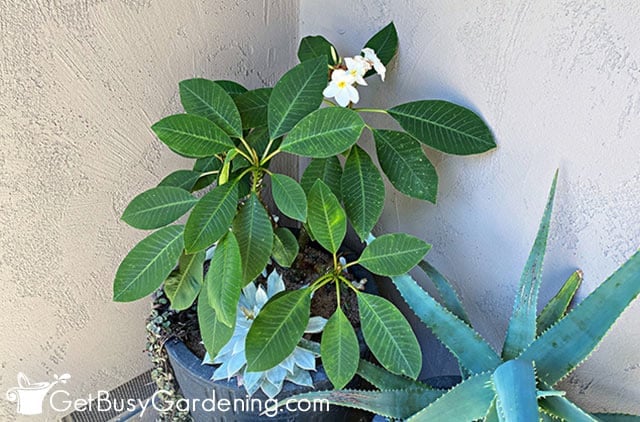
FAQs
Here I’ve answered some of the most commonly asked questions about growing plumeria in pots. If yours isn’t on the list, please add it to the comments section below.
Do plumerias like large pots?
Plumerias like pots that are proportionate to their size, however they will eventually grow to fill a large one. But big pots are heavier and harder to move, so keep that in mind if you’ll ever need to relocate it.
How big of a pot does a plumeria need?
A plumeria needs a pot that’s big enough to support their height without tipping over. A good estimate is 1 gallon in size for every 1 foot of trunk.
What kind of pot is best for plumeria?
The best kind of pot for plumeria is one with good drainage. Plastic and fabric are lightweight and easy to move, while terracotta is great if you live in a rainy region, and heavy enough to keep them from tipping over.
How do I get my potted plumeria to bloom?
The key to get your potted plumeria to bloom is giving it plenty of fertilizer and full sun. They’re very heavy feeders, and need a lot of nutrients in order to flower, especially in containers.
Growing plumeria in pots is a great way to enjoy them no matter where you live. Use the tips in this guide to create an ideal container environment so they can thrive for years to come.
If you want to learn all there is to know about maintaining healthy indoor plants, then you need my Houseplant Care eBook. It will show you everything you need to know about how to keep every plant in your home thriving. Download your copy now!
More About Container Gardening
Share your tips for growing plumeria in pots in the comments section below.
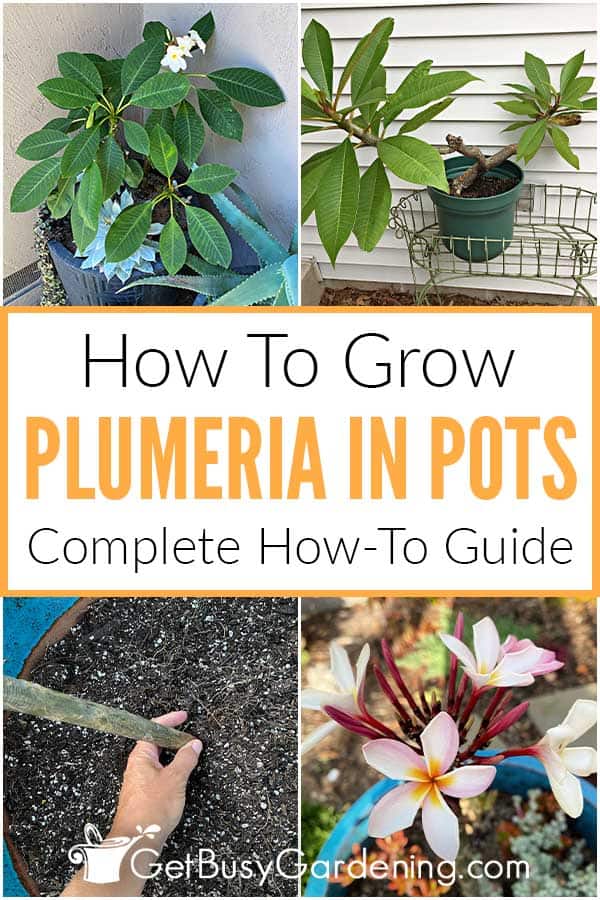

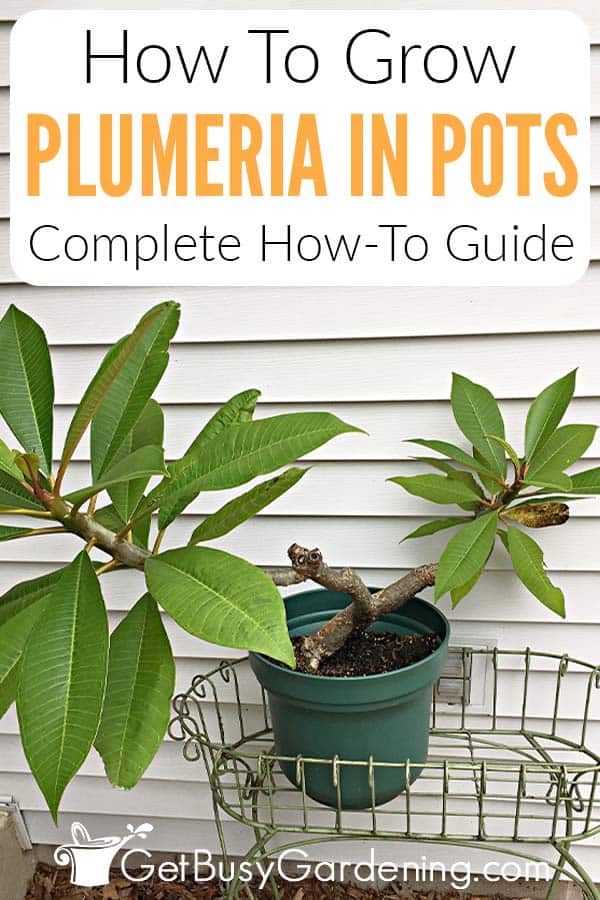

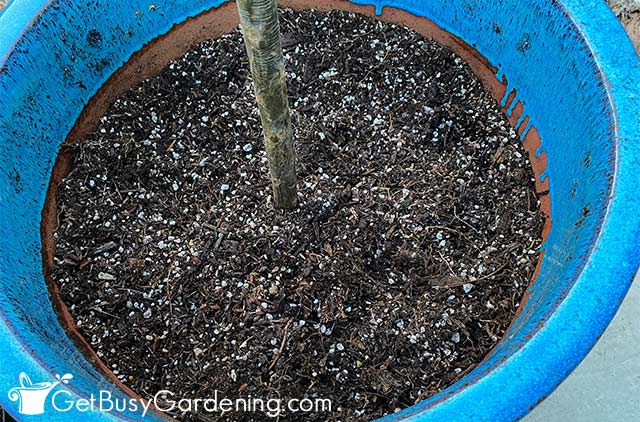


Dana Kelley says
I live in Oklahoma. The summers here are usually in the high 90s or low 100s. I have a screened in back porch that gets lots of indirect sunlight, but I’m not sure about the heat. Can plumeria take that kind of heat if it’s sheltered from direct sunlight? Should I keep it indoors or will it be OK outdoors? Thank you for your tips and advice. This is my first plumeria plant so I want to get it right.
Amy Andrychowicz says
As long as the porch is screened in so your plumeria gets air – and not sealed or enclosed, your plants will be fine.
Sandra Harvey says
Hi Amy my name is Sandra Harvey I love plumerias and I have a lot of them different colors I live in Missouri so I have my son help me put them away for the winter as he was helping me with them this year he accidentally broke a couple of limbs off some and he apologized. I told him don’t worry I will just root them. He said yeah like you need more😁 I turned my husbands work shop into my winter plant room 😁
JAN says
I was gifted a plumeria last fall which I overwintered inside last winter . I transplanted into a pot with good drainage and new soil. Shortly afterwards, the leaves dropped but the stems remained firm and alive. I live in northeast Texas (zone 8b). I have moved the plant outdoors now that our weather is warming up. How long should it take for the plant to come out of dormancy and produce new leaves? I have read through your posts and comments but I’m unclear on if I should fertilize prior to seeing new growth. If I remove part of a stem, will that trigger new growth? Thanks for your help!
Amy Andrychowicz says
I have a detailed section in my post about how to overwinter plumerias that is all about bringing them out of dormancy. But in short, it can take a month (or even longer if it’s chilly) before plumerias will start putting on new leaves, and you should wait to fertilize it until the leaves appear. But read the article I linked to for the full instructions. Good luck!
Kasey Armstead says
Hi. I have 3 plumeria stems with leaves in one pot. They have been doing well all summer I live in the pacific. North west. How can I keep them alive and will they bloom inside over winter please help.
Amy Andrychowicz says
Potted plumeria plants are very easy to overwinter indoors, here’s how. They usually go dormant and may or may not drop all of their leaves. They don’t usually flower during the winter, but mine bloomed in December one year. So it can happen.
Joan mahony says
i’m new to growing frangipani, when you say prune does that mean to cut all the flowers and leaves off just leaving the bare branches??
Amy Andrychowicz says
You don’t need to prune your plumeria if you’re happy with the shape and it’s healthy. If it’s leggy or has any dead/rotting/diseased branches, then you can trim those back. Otherwise, there’s no need.
Earl Thomas says
My potted plumeria accidentally got some diluted white vinegar spilt in it and leaves are starting to drop.Can the plant be saved.
Amy Andrychowicz says
Oh no, that doesn’t sound good. I would flush your plumeria’s soil with fresh water and then make sure to let it drain completely out of the pot (so it’s not left soaking). Good luck, I hope it works.
Terri Brown says
My plumara tree has Rust…..
I just pruned it way way down but I saved them stems with flowers on them
Can I plant just the srem to start over???
Amy Andrychowicz says
Yes, and it’s actually quite easy. Here are my step by step instructions for how to root your plumeria stem cuttings.
Donna Jo C Rossman says
My plumeria is about 5 feet tall, if I cut it back to 2 feet will it spread out. Right now it is 1 stem. It does bloom. And can I repot the cut off part
Amy Andrychowicz says
Yes, you can prune your plumeria to make it branch out. Just be sure to make the cuts at a downward angle to avoid water pooling in the wounds, or it could cause the stems to rot.
Henry Gomes says
Thank you for the tips taking care of my potted plumeria plant
Amy Andrychowicz says
You’re welcome!
Dawn Pierce says
I have had my cuttings for over a year but I’m not even getting any leaves do I need to replant and fertilize more?
Amy Andrychowicz says
Oh weird that your plumeria cuttings haven’t grown any leaves in over a year! First, make sure they’re still alive by gently squeezing all along the stem. It should feel firm and healthy. If any part of it is soft or dried out, then they likely are no longer alive. Otherwise, try giving them plenty of heat and light. Indoors you can place them on a heat mat and add a grow light, otherwise move them to a warm and sunny spot outdoors this summer to see if that will break their dormancy. Definitely don’t repot or fertilize them until after they start growing.